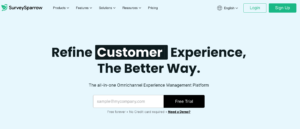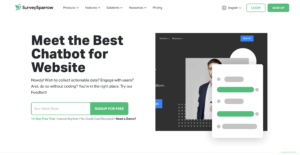Customer Experience
Customer Experience Insights: A Comprehensive Guide for Companies
Article written by Jaby K J
Growth Marketer at SurveySparrow
10 min read
19 September 2025

Get this – your customers are talking, whispering, and sometimes even shouting out the secrets to your business’s success. Every interaction, every click, every purchase, they’re leaving a trail of breadcrumbs known as ‘Customer Experience Insights.’
This isn’t just data; it’s a roadmap to creating a brand that resonates, a service that satisfies, and a product that’s not just bought but loved. If you’re ready to stop guessing and start growing, dive into this comprehensive guide that deciphers these secret codes and teaches you how to wield them for the growth of your business.
Now let’s turn customer experience insights into success ladders.
What is Customer Experience Insights?
Customer Experience Insights refer to the wealth of data procured from the interactions and behaviors of customers with your brand.
It is more or less a panoramic, 360-degree view of your customer’s journey, every twist, every turn, every pause laid bare for you to understand. That’s what Customer Experience Insights are. They’re not just numbers on a spreadsheet, but a tale of human behavior, emotions, and expectations, a treasure trove of clues about what your customers desire and detest.
These insights are gathered from every touchpoint – every click on your website, every review left on your product, every social media interaction, every customer service call, and so on. They form a wealth of data that tells you what works, what doesn’t, where you shine, and where you stumble.

What is the Importance of Customer Experience Insights
n a world where businesses compete intensely for consumer attention, Customer Experience Insights serve as the invaluable key to success. By delving into the hearts and minds of your customers, these insights empower you to revolutionize their experiences and establish a truly customer-centric brand. In the saturated market, understanding and prioritizing the customer’s needs become your Midas touch, enabling your business to stand out and thrive.
Customer Experience Insights are not a one-time thing; they evolve as your customers do. They’re dynamic, continually providing fresh information, illuminating the path to enhanced products, improved services, and a loyal customer base.
How to Gather Customer Experience Insights?
Gathering Customer Experience Insights involves a systematic approach that combines various methods to understand and analyze customer interactions, feedback, and preferences.
Here’s a step-by-step guide on how to do it:
1. Custom Surveys
- Conducted through online forms, email surveys, or website/mobile app integration.
- Gather structured feedback and quantitative data on various aspects of the customer experience.
- You can make use of SurveySparrow to create seamless customer surveys.
14-day free trial • Cancel Anytime • No Credit Card Required • No Strings Attached
2. Social Media Listening
- Monitor social media platforms like Twitter, Facebook, Instagram, and LinkedIn.
- Understand customer sentiments, opinions, and conversations related to the brand.
- Utilize social media listening tools to track mentions, hashtags, and trends.
3. Online Reviews and Rating
- Monitor online review platforms like Google Reviews, TripAdvisor, etc.
- Gain insights into overall customer satisfaction, pain points, and areas for improvement.
- Actively respond to reviews to address concerns and demonstrate commitment to customer satisfaction.
4. Customer Support Interactions
- Analyze customer support logs and transcripts from phone calls, live chat, or email exchanges.
- Identify recurring issues, measure response times, and evaluate support team effectiveness.
5. Website and App Analytics
- Utilize tools like Google Analytics to track metrics such as page views, bounce rates, and conversion rates.
- Gain insights into customer behavior, preferences, and pain points while navigating digital properties.
- Visual representations like heatmaps and clickstream analysis highlight areas for improvement.
6. Customer Feedback Management Platforms
- Centralize collection, analysis, and management of customer feedback from various sources.
- Aggregate feedback from surveys, social media, online reviews, and customer support interactions.
- Provide robust analytics and reporting capabilities to identify trends and prioritize improvement initiatives.
7. User Testing and Usability Studies
- Observe and gather customer feedback as they interact with products, services, or prototypes.
- Conduct in-person or remote sessions to assess ease of use, identify pain points, and uncover improvement opportunities.
- Provide qualitative insights for refining the user experience and enhancing customer satisfaction.
By utilizing these platforms, companies can gather comprehensive customer experience insights to drive improvements, enhance satisfaction, and build stronger customer relationships.

How to Harness Data and Analytics for Insightful Customer Experiences
Leveraging Customer Feedback
Customer feedback is a goldmine of insights that can drive improvements in customer experience. Gathering feedback through surveys, interviews, or online reviews allows companies to understand customer preferences, pain points, and areas for improvement. Analyzing and acting upon this feedback demonstrates a company’s commitment to listening to its customers and continuously enhancing their experience.

Unstructured Data Analysis: Mining the Gold in Customer Conversations
In addition to structured feedback, unstructured data analysis can provide valuable insights into customer experiences. By utilizing natural language processing and sentiment analysis techniques, companies can extract meaningful information from sources such as customer support chats, social media conversations, and online forums. This unstructured data analysis unveils hidden patterns, emerging trends, and customer sentiments, enabling businesses to make data-driven decisions and enhance the customer experience.
Predictive Analytics: Enhancing Personalization and Anticipating Customer Needs
Predictive analytics leverages historical data to forecast future customer behavior and preferences. Companies can personalize their offerings, anticipate customer needs, and provide tailored recommendations by analyzing past interactions, purchase history, and demographic information. This level of personalization not only improves the customer experience but also drives customer satisfaction and loyalty.
How to Humanize the Customer Experience
Empathy: The Foundation of Exceptional Customer Interactions
Empathy is a critical element in building strong customer relationships. It involves understanding and sharing the emotions and experiences of customers, putting oneself in their shoes, and demonstrating genuine care and concern. By training employees to cultivate empathy, companies can create a culture of compassion that shines through in every customer interaction.
2. Training and Empowering Customer-Facing Employees
Customer-facing employees play a vital role in delivering exceptional experiences. By providing comprehensive training, companies can equip their employees with the necessary skills and knowledge to understand customer needs, resolve issues effectively, and exceed expectations. Empowering employees to make decisions and take ownership of customer interactions further enhances the customer experience, as it allows for personalized and timely solutions.
3. Tailoring Experiences to Individual Customers
Personalization is no longer a luxury but an expectation in today’s customer-centric landscape. By leveraging customer data and insights, companies can create personalized experiences that cater to individual preferences and needs. From personalized recommendations to targeted marketing campaigns, personalization demonstrates that a company values its customers as unique individuals, fostering stronger connections and loyalty.
How to Gauge Continuous Improvement and Innovation
Implement a Culture of Continuous Improvement
Customer experience is an ongoing journey, and companies must embrace a culture of continuous improvement. This involves collecting feedback, analyzing metrics, identifying areas for enhancement, and implementing iterative changes.
By fostering a constant learning and adaptation mindset, companies can stay ahead of evolving customer expectations and ensure that their experiences remain relevant and impactful.
- Staying Ahead in a Dynamic Customer Landscape
Innovation is crucial for companies seeking to differentiate themselves in a crowded marketplace. By actively seeking out new technologies, trends, and ideas, companies can explore innovative ways to enhance the customer experience.
Whether it’s leveraging artificial intelligence, integrating augmented reality, or embracing new communication channels, innovation can propel companies to the forefront of customer-centricity.
- 3. Technology Enablers: From AI to IoT
Technology plays a pivotal role in enabling exceptional customer experiences. Artificial intelligence (AI), machine learning, and the Internet of Things (IoT) are just a few examples of technologies that can enhance customer interactions.
AI-powered chatbots & AI Surveys can provide instant support, while IoT devices can create seamless and personalized experiences. By leveraging these technologies strategically, companies can elevate their customer experience initiatives to new heights.
How to Gather Customer Insights Using AI
Here’s how AI can be used to gather customer experience insights:
1. Sentiment Analysis
- AI-powered sentiment analysis tools can analyze customer feedback from various sources, such as social media posts, reviews, and customer support interactions.
- It automatically detects and categorizes sentiment as positive, negative, or neutral, providing insights into customer opinions and emotions.
2. Natural Language Processing (NLP)
- NLP techniques enable AI systems to understand and extract meaning from unstructured customer data, including text, voice, and chat interactions.
- AI models can analyze customer conversations to identify patterns, topics, and customer preferences.
3. Chatbots and Virtual Assistants
- AI-powered chatbots and virtual assistants can engage with customers in real time, collecting data and capturing insights during the interaction.
- Through conversational interfaces, chatbots can understand customer queries, address common issues, and gather feedback.

4. Personalization and Recommendation Engines
- AI algorithms can analyze customer data to provide personalized recommendations, product suggestions, and tailored experiences.
- By understanding customer preferences, AI can offer relevant offers, content, and suggestions, enhancing the overall customer experience.
5. Predictive Analytics
- AI models can leverage historical customer data to make predictions and forecasts about customer behavior and preferences.
- By analyzing past interactions, purchase history, and demographic information, companies can anticipate customer needs and tailor experiences accordingly.
6. Image and Video Analysis
- AI-powered image and video analysis can analyze visual content shared by customers on social media platforms. While primarily used for insights, some visuals may originate from tools like generative AI art platforms.
- This analysis can provide insights into customer experiences, brand interactions, and product usage.
7. Voice Analytics
- AI-powered voice analytics can process and analyze customer calls, extracting valuable insights from recorded conversations.
- It can identify sentiment, detect customer emotions, and uncover key themes or issues raised during the call.
8. Behavioral Analytics
- AI algorithms can analyze customer behavior data, such as website clicks, navigation patterns, and purchase history.
- This analysis can reveal customer preferences, pain points, and opportunities for improvement in the user experience.
By harnessing the power of AI, businesses can gain deeper and more actionable customer experience insights. From sentiment analysis and NLP to chatbots, personalization, and predictive analytics, AI enables companies to extract valuable information, enhance customer interactions, and make data-driven decisions to improve the overall customer experience.
Final Thoughts
To gather comprehensive customer experience insights, companies can leverage a range of platforms and tools. From conducting customer surveys and monitoring social media conversations to analyzing online reviews and ratings, tracking website and app analytics, utilizing customer feedback management platforms, and conducting user testing and usability studies, each platform offers unique perspectives and data sources.
By utilizing these platforms effectively, companies can gain valuable insights into customer preferences, pain points, and satisfaction levels. This enables them to make data-driven decisions and continually enhance the customer experience. Remember, a multi-faceted approach to gathering customer experience insights ensures a comprehensive understanding of customer needs and preferences.

Make your customers feel heard. Turn feedback into loyalty with SurveySparrow's CX platform.
Jaby K J
Once chasing a half-cooked Ph.D. dream in Literature amidst the stacks of academia, Jaby has successfully pivoted to become a product marketer in the SaaS industry, leveraging a rich background in research and a deep understanding of creating compelling narratives.
Related Articles

Customer Experience
12 Tips For Exceptional Omnichannel Customer Experience
16 MINUTES
22 June 2019

Customer Experience
A Guide to Managing Remote Customer Service
19 MINUTES
4 May 2020

Customer Experience
Tips To Ace Personalized Customer Experiences Like Industry Leaders
8 MINUTES
28 June 2023

Customer Experience
Exploring the World of Customer Service - An Interview with John Dijulius
11 MINUTES
9 December 2019
